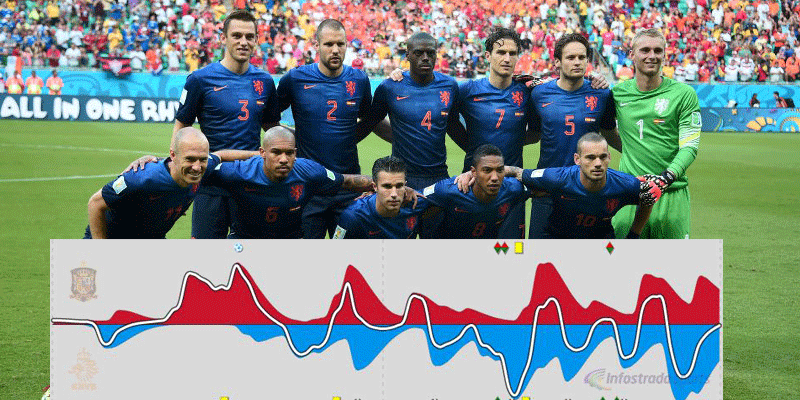
- Research , Student
- 14/10/2014
‘Wave’: the match at a glance
The Netherlands humiliated Spain by 5-1 in the recent World Cup soccer. But a draw would have been a fairer outcome. At least, if you look at the visuals made by Computer Science student Marijn Grootjans at Eindhoven University of Technology (TU/e) based on the match statistics. His platform – called ‘Wave’ – on which he graduated today, gives an at-a-glance representation of a soccer match. And that shows, for example, that based on the number of shots Spain is equal to the Netherlands, but Holland was quite simply the much more effective team.
Grootjans used data gathered by the sports data and measurement organization Infostrada Sports for virtually all soccer matches in the European and international competitions. This included data on goals, penalties, shots and corners. Data was collected for example on the position on the field from which the shot was taken, by which player, with which foot, whether it was a shot at goal and whether it was the keeper or another player who stopped the ball.
Grootjans developed a model to represent this data in clear visuals. For example a ‘heat map’ is made for each player with a cloud showing all the positions on the field from which that player has ever taken a shot. Different colors show the frequencies with which shots by each player and from each position have led to goals. This is valuable information for football clubs. “It provides an efficient and objective way to compare the positions of players like Messi, Ronaldo or Robben”, Grootjans explains.
It’s also possible to make a ‘Wave diagram’ with colored waves that give an impression of the shots, penalties and goal shots of each team. The number and height of the peaks show the ‘entitlement’ of each team to the victory. “This shows the progress of the match at-a-glance, and whether the right winner emerged”, says Grootjans. But the diagram also indicates the amusement value of a match: many high peaks in a match mean there was a lot of attaching.
The ultimate reward for Grootjans’ work is that Infostrada Sports actually used his model during the World Cup. The Waves of a number of the matches have been published by Infostrada Sports on their websites and Twitter channels, and have been used by a number of international media.
Source: Persteam TU/e
Discussion